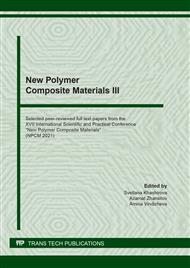[1]
E.A. Sergeeva, V.S. Zheltukhin, I.Sh. Abldullin, Modification of synthetic fibrous materials and products by nonequilibrium low-temperature plasma. Properties, structure, technology, Kazan, (2011).
Google Scholar
[2]
I.I Karimullin, A.E. Karnoukhov, E.A. Skidchenko et al, Research of the effect of radio-frequency capacitive plasma treatment in the medium of hydrocarbon gas on properties of the surface of glass fibers, Journal of Physics: Conference Series. 1328 (2019) 012040.
DOI: 10.1088/1742-6596/1328/1/012040
Google Scholar
[3]
I.Sh. Abdullin, V.S. Zheltukhin, N.F. Kashapov, High-frequency plasma-jet processing of materials at reduced pressures. Theory and practice of application, Kazan, (2000).
Google Scholar
[4]
A.F. Gaisin, Investigation of the effect of a low-temperature plasma of vapor–gas discharges with the use of electrolytic electrodes at lower pressure on products of complex shape, Inorganic Materials: Applied Research. 8(3) (2017) 392–395.
DOI: 10.1134/s207511331703008x
Google Scholar
[5]
V.S. Zheltukhin, Modification of synthetic fibrous materials and products by nonequilibrium low-temperature plasma. Theory, models, methods, Kazan, (2011).
Google Scholar
[6]
Y.A. Timoshina, E.F. Voznesensky, A.E. Karnoukhov et al, Influence of plasma modification on free surface energy of synthetic fibrous materials, Journal of Physics: Conference Series. 1588 (2020) 012052.
DOI: 10.1088/1742-6596/1588/1/012052
Google Scholar
[7]
A.V. Ostrovskaya, I.I. Latfullin, Investigation of the influence of the fluorine content in the alcohol-modifier molecule on the properties of amino resins, Bulletin of Kazan Technological University. 15 (2012) 114–116.
Google Scholar
[8]
V.V. Vasiliev, V.V. Sysoev, S.L. Krivosheev, Improving the quality of urea-formaldehyde resins and binders for particle boards, Woodworking. 6 (2008) 22–24.
Google Scholar
[9]
V.E. Tsvetkov, T.N. Karpova, Research of technological properties of modified urea-formaldehyde resins, Adhesives. Sealants. Technology. 6 (2011) 16–17.
Google Scholar
[10]
N. Korneeva, V. Kudinov, I. Krylov, V. Mamonov, Properties of fiber reinforced plastics under static and dynamic loading conditions, Polymer Engineering & Science, 57, 7 (2017) 693–696.
DOI: 10.1002/pen.24607
Google Scholar


